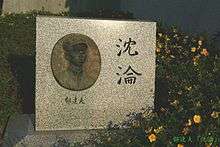Yu Dafu
| Yu Dafu | |
|---|---|
 | |
| Born |
December 7, 1896 Fuyang, Zhejiang, China |
| Died |
September 17, 1945 (aged 48) Sumatra, Dutch East Indies |
| Occupation | Writer and poet |
| Nationality | Chinese |
Yu Dafu (simplified Chinese: 郁达夫; traditional Chinese: 郁達夫; pinyin: Yù Dáfū; Wade–Giles: Yu Ta-fu) (December 7, 1896 – September 17, 1945). Born in Fuyang, Zhejiang province, was a modern Chinese short story writer and poet.
Early years
Yu Dafu's father died when he was three, leaving the family poverty-stricken and destitute. He received a number of scholarships through the Chinese government and went on to receive a traditional Chinese education in Hangzhou. Chronologically he studied in Jiangxing-Fu Middle School (before he came to Hangzhou), Hangzhou-Fu Middle School, Yuying Academy[1] (育英学堂, formerly of Zhejiang University).
In 1912, he entered Hangchow University (later its major part merged into Zhejiang University) preparatory through examination. He was there only for a short period before he was expelled for participation in a student strike.[2]
He then moved to Japan, where he studied economics at the Tokyo Imperial University between 1913 and 1922, where he met other Chinese intellectuals (namely, Guo Moruo, Zhang Ziping and Tian Han). Together, in 1921 they founded the Chuangzao she 創造社 ("Creation Society"), which promoted vernacular and modern literature. One of his earlier works Chenlun 沉淪, also his most famous, published in Japan in 1921. The work had gained immense popularity in China, shocking the world of Chinese literature with its frank dealing with sex, as well as grievances directed at the incompetence of Chinese government at the time.
In 1922, he returned to China as a literary celebrity and worked as the editor of Creation Quarterly, editing journals and writing short stories. In 1923, after an attack of tuberculosis, Yu Dafu directed his attention to the welfare of the masses.
In 1927, he worked as an editor of the Hongshui literary magazine. He later came in conflict with the Communist Party of China and fled back to Japan.
Second Sino-Japanese war
After the start of the Second Sino-Japanese war, he returned to China and worked as a writer of anti-Japanese propaganda in Hangzhou. From 1938 to 1942, he worked as a literary editor for the newspaper Sin Chew Jit Poh in Singapore.
In 1942 when the Imperial Japanese Army invaded Singapore, he was forced to flee to Sumatra. Known under a different identity, he settled there among other overseas Chinese and began a brewery business with the help of the locals. Later he was forced to help the Japanese military police as an interpreter when it was discovered that he was one of the few "locals" in the area who could speak Japanese.
In 1945, he was arrested by the Kempeitai when his true identity was finally discovered. It is believed that he was executed by the Japanese shortly after the surrender of Japan.
Works

- Chenlun 沉淪 Sinking (1921)
- Nine Diaries 日記九種 (1927)
- Guoqu 過去 The Past (1927)
- Chuben 出奔 Flight (1935)
His most popular work, breaking all Chinese sales records, was Nine Diaries, which detailed his affair with the writer Wang Yingxia, whom he married in 1928. The most critically acclaimed work is Guoqu or "The Past", written in 1927.
Main Themes
Yu Dafu's work is considered by leading scholars to be iconoclastic and controversial.[3]:102–103 His heroes, which supposedly reflect the author[3]:109 are "By turns voyeur, fetishist, homosexual, masochist, and kleptomaniac."[3]:109 The sexually repressed heroes cannot relate to women.[4] The alleged 'decadence' of Yu Dafu's novels, whether in a pejorative or in an aesthetic sense (i.e.'Decadence' as an artistic movement) has been considered by some Chinese Marxist critics to be a sign of Yu Dafu's moral corruption,[5]:111 but Shih argues that Yu Dafu's writings constitute a serious-minded critique of China's political plight and perceived social conformism.[5]:113–114 Indeed, concern for the person and for the nation are intimately linked in his work, and the effeminate and ailing body serves as a metaphor for the weak and sickly nation.[5]:115–123
References
- Encyclopædia Britannica 2005 Ultimate Reference Suite DVD, article- "Yü Ta-fu"